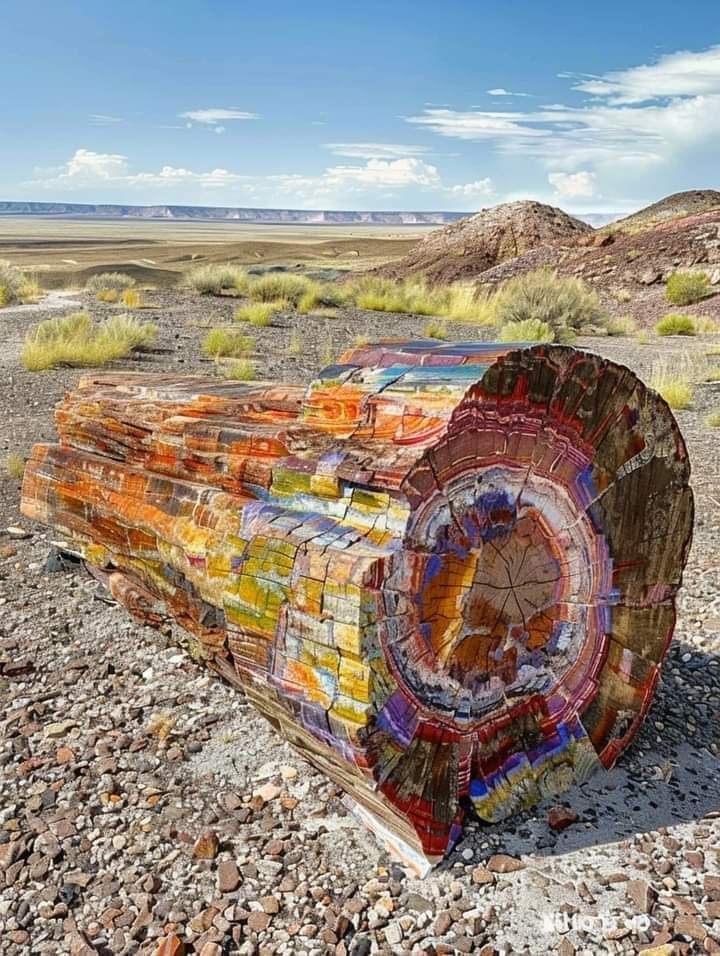Petrified Forest National Park is an American national park located in Navajo and Apache counties in northeastern Arizona. Named for its large deposits of petrified wood, the park covers about 346 square miles (900 km2), and includes semi-desert shrub-steppe as well as highly eroded and colorful badlands. The park's headquarters is located about 26 miles (42 km) east of Holbrook along Interstate 40 (I-40), which parallels the South Transcon Line. The site, the northern portion of which extends into the Painted Desert, was declared a national monument in 1906 and a national park in 1962. The park has an average elevation of about 5,400 feet (1,600 m), and has a dry, windy climate with temperatures ranging from In the summer it is about 100°F (38°C) to winter lows well below freezing. The park has more than 400 species of plants, dominated by grasses such as punchweed, blue grama, and sacaton. Animals include larger animals such as pronghorn, coyotes, and lynx; many small animals, such as deer, mice, snakes, lizards and seven species of amphibians; And more than 200 species of birds, some of which are permanent residents and many of which are migratory. About one-third of the park is designated wilderness—50,260 acres (79 sq mi; 203 km2)—
The Petrified Forest is famous for its fossils, especially deciduous trees that lived in the Late Triassic, about 225 million years ago. The deposits containing the fossil trunks are part of the colorful and widespread Chinle Formation, from which the Painted Desert gets its name. Beginning about 60 million years ago, the Colorado Plateau, of which the park is a part, was pushed upward by tectonic forces and subjected to further erosion. All of the park's rock layers above the Chinle River, except for younger geological strata in parts of the park, have been removed by wind and water. In addition to fossilized tree trunks, fossils found in the park included Late Triassic ferns, cycads, ginkgos, and many other plants as well as animals including giant reptiles called phytosaurs, large amphibians, and early dinosaurs. Paleontologists have discovered and studied the park's fossils since the early 1900s.
The Petrified Forest is famous for its fossils, especially deciduous trees that lived in the Late Triassic, about 225 million years ago. The deposits containing the fossil trunks are part of the colorful and widespread Chinle Formation, from which the Painted Desert gets its name. Beginning about 60 million years ago, the Colorado Plateau, of which the park is a part, was pushed upward by tectonic forces and subjected to further erosion. All of the park's rock layers above the Chinle River, except for younger geological strata in parts of the park, have been removed by wind and water. In addition to fossilized tree trunks, fossils found in the park included Late Triassic ferns, cycads, ginkgos, and many other plants as well as animals including giant reptiles called phytosaurs, large amphibians, and early dinosaurs. Paleontologists have discovered and studied the park's fossils since the early 1900s.
Petrified Forest National Park is an American national park located in Navajo and Apache counties in northeastern Arizona. Named for its large deposits of petrified wood, the park covers about 346 square miles (900 km2), and includes semi-desert shrub-steppe as well as highly eroded and colorful badlands. The park's headquarters is located about 26 miles (42 km) east of Holbrook along Interstate 40 (I-40), which parallels the South Transcon Line. The site, the northern portion of which extends into the Painted Desert, was declared a national monument in 1906 and a national park in 1962. The park has an average elevation of about 5,400 feet (1,600 m), and has a dry, windy climate with temperatures ranging from In the summer it is about 100°F (38°C) to winter lows well below freezing. The park has more than 400 species of plants, dominated by grasses such as punchweed, blue grama, and sacaton. Animals include larger animals such as pronghorn, coyotes, and lynx; many small animals, such as deer, mice, snakes, lizards and seven species of amphibians; And more than 200 species of birds, some of which are permanent residents and many of which are migratory. About one-third of the park is designated wilderness—50,260 acres (79 sq mi; 203 km2)—
The Petrified Forest is famous for its fossils, especially deciduous trees that lived in the Late Triassic, about 225 million years ago. The deposits containing the fossil trunks are part of the colorful and widespread Chinle Formation, from which the Painted Desert gets its name. Beginning about 60 million years ago, the Colorado Plateau, of which the park is a part, was pushed upward by tectonic forces and subjected to further erosion. All of the park's rock layers above the Chinle River, except for younger geological strata in parts of the park, have been removed by wind and water. In addition to fossilized tree trunks, fossils found in the park included Late Triassic ferns, cycads, ginkgos, and many other plants as well as animals including giant reptiles called phytosaurs, large amphibians, and early dinosaurs. Paleontologists have discovered and studied the park's fossils since the early 1900s.
0 Comments
0 Shares
265 Views

